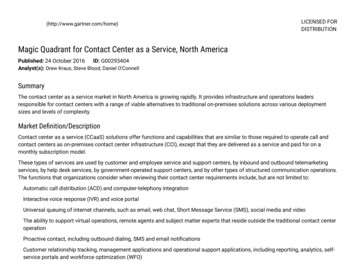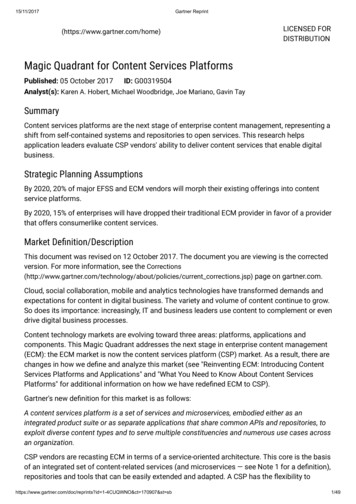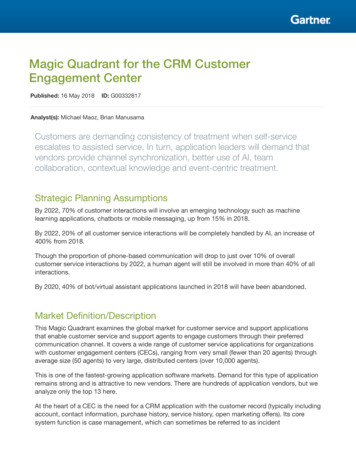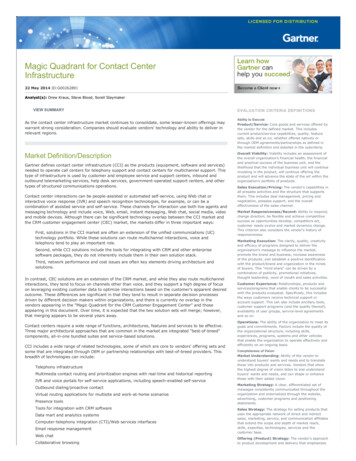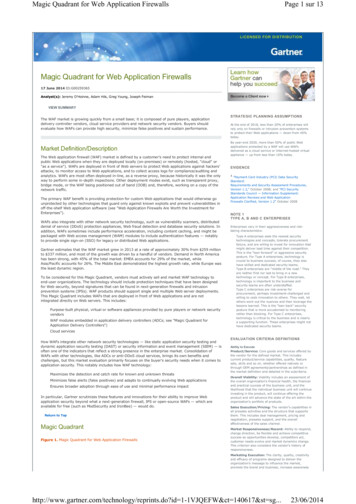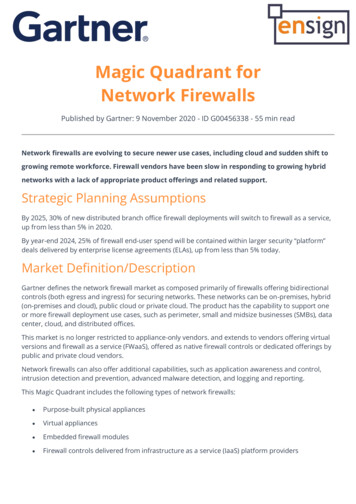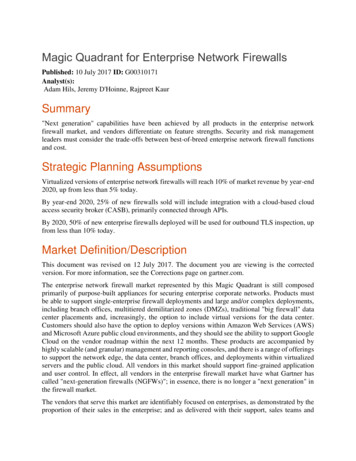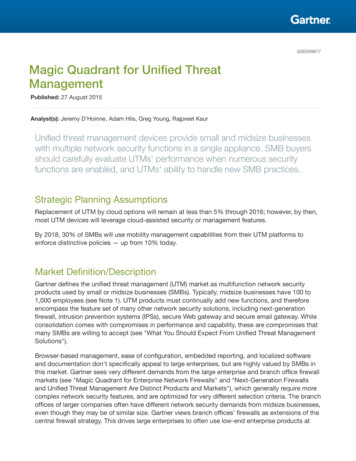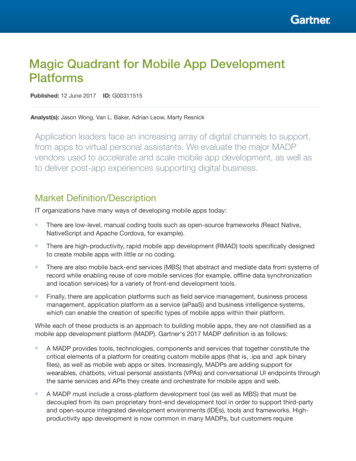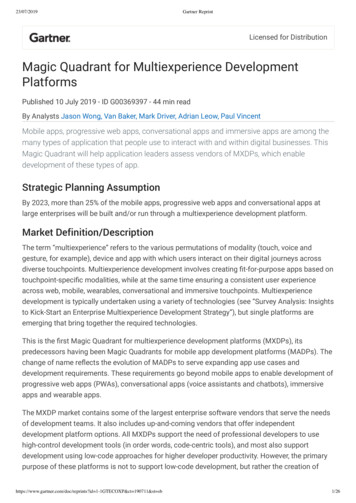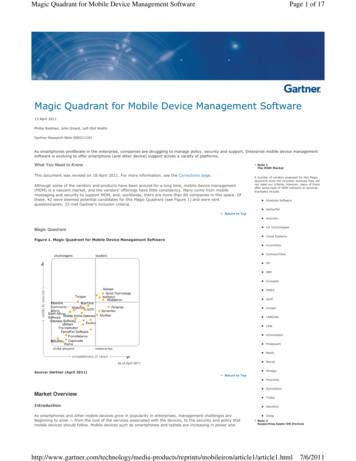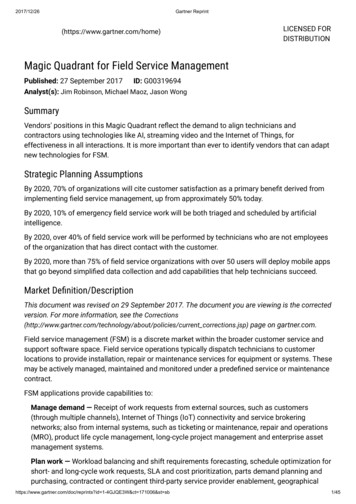
Transcription
2017/12/26Gartner Reprint(https://www.gartner.com/home)LICENSED FORDISTRIBUTIONMagic Quadrant for Field Service ManagementPublished: 27 September 2017 ID: G00319694Analyst(s): Jim Robinson, Michael Maoz, Jason WongSummaryVendors' positions in this Magic Quadrant reflect the demand to align technicians andcontractors using technologies like AI, streaming video and the Internet of Things, foreffectiveness in all interactions. It is more important than ever to identify vendors that can adaptnew technologies for FSM.Strategic Planning AssumptionsBy 2020, 70% of organizations will cite customer satisfaction as a primary benefit derived fromimplementing field service management, up from approximately 50% today.By 2020, 10% of emergency field service work will be both triaged and scheduled by artificialintelligence.By 2020, over 40% of field service work will be performed by technicians who are not employeesof the organization that has direct contact with the customer.By 2020, more than 75% of field service organizations with over 50 users will deploy mobile appsthat go beyond simplified data collection and add capabilities that help technicians succeed.Market Definition/DescriptionThis document was revised on 29 September 2017. The document you are viewing is the correctedversion. For more information, see the t/policies/current corrections.jsp) page on gartner.com.Field service management (FSM) is a discrete market within the broader customer service andsupport software space. Field service operations typically dispatch technicians to customerlocations to provide installation, repair or maintenance services for equipment or systems. Thesemay be actively managed, maintained and monitored under a predefined service or maintenancecontract.FSM applications provide capabilities to:Manage demand — Receipt of work requests from external sources, such as customers(through multiple channels), Internet of Things (IoT) connectivity and service brokeringnetworks; also from internal systems, such as ticketing or maintenance, repair and operations(MRO), product life cycle management, long-cycle project management and enterprise assetmanagement systems.Plan work — Workload balancing and shift requirements forecasting, schedule optimization forshort- and long-cycle work requests, SLA and cost prioritization, parts demand planning andpurchasing, contracted or contingent third-party service provider enablement, d 1-4GJQE3W&ct 171006&st sb1/45
2017/12/26Gartner Reprintinformation system (GIS)-based planning.Inform and enable technicians — Apps on mobile and wearable devices for GPS tracking,telematics, equipment work history, service collaboration and customer communication,knowledge and work instruction management, inspections, safety forms, parts sourcing andcustomer quoting.Debrief work orders — Online or offline mobile collection of time and parts used, taskscompleted, updates to equipment records, customer recommendations, sign-offs, approvalsfor additional work and satisfaction surveys.Perform analysis and integration — Field service performance management, predictiveanalytics, alerts and notifications, and APIs and connectors for ERP, CRM and GIS applicationintegration.For organizations that need to handle complex service use cases for mission-critical equipment,provide a hybrid of on-site and in-depot service, or have FSM-driven pricing, end-to-end FSMproducts should extend capabilities to:Manage additional operations — Installed equipment management, maintenance agreementmanagement, maintenance plans, warranty and claims management, reverse logistics, depotrepair, equipment supersession, engineering change requests, customer pricing managementand pro forma invoice preparation.FSM products operate across multiple communication channels (websites, supply solutions,third-party service brokering solutions and analytics). FSM solutions touch software in severalmarkets, such as CRM, ERP, enterprise asset management, IoT, workforce management, vendormanagement, product life cycle management and supply chain markets such as transportationmanagement and fleet management. Although several FSM vendors have capabilities in theseareas, these are not their focus.Magic QuadrantFigure 1. Magic Quadrant for Field Service Managementhttps://www.gartner.com/doc/reprints?id 1-4GJQE3W&ct 171006&st sb2/45
2017/12/26Gartner ReprintSource: Gartner (September 2017)Vendor Strengths and CautionsAccruent (Verisae)U.S.-based Accruent (http://www.accruent.com/) acquired Verisae (http://www.verisae.com/) inSeptember 2016. It is a Niche Player on the basis of its industry focus and support for third-partyservice, as well as its geographical focus on North America (it also has a small presence inEMEA and in Asia/Pacific). Our analysis focuses on the FSM products from the Verisae portfolio.Accruent's Verisae portfolio supports end-to-end field service use cases with a combination ofproducts: vx Maintain (for contracts, planned maintenance and operations) and vx Field (for workplanning and schedule optimization, technician enablement and debriefing). Accruent's industrystrategy differs from Verisae's former industry strategy, but Accruent is likely to continue to focuson Verisae's traditional industries (primarily retail, utilities and telecommunications), whileextending vx Field's range of targets to include organizations in other industries, such ascorporate real estate, healthcare, education and government, especially in use cases where thehttps://www.gartner.com/doc/reprints?id 1-4GJQE3W&ct 171006&st sb3/45
2017/12/26Gartner Reprintfacility owner works with an ecosystem of vendors. The Verisae portfolio also covers fieldservice for connected equipment with vx Field and vx Maintain, while the vx Sustain, vx Conserveand vx Observe offerings cover management for regulated substances (such as refrigerants),energy usage and equipment alarms and performance data. We estimate that Accruent hasbetween 50,000 and 65,000 users of the FSM solutions in the Verisae portfolio.STRENGTHSIndustry focus: Accruent's Verisae portfolio addresses the needs of facility owners, theirassets and their networks of third-party service resources. This helps promote transparencyand efficient sharing of, for example, alarm data to improve diagnostics, work order approvalsand capacity-based schedule optimization across first- and third-party resources.Product depth: vx Field is a mature offering that includes deep capabilities for managingpaperwork flow and communications for third-party service (which Accruent calls work ordermarshalling), connected equipment, parts management (including returns), workflow andschedule optimization.Sales strategy: Accruent has achieved growth in recurring revenue with the vx products.Accruent sales teams have been trained to sell the Verisae portfolio to expand the salesfootprint.CAUTIONSMarketing execution: Since the acquisition, Accruent has focused on rebranding andintegrating elements of the Verisae business, as well as on integrating the vx products withother parts of the Accruent portfolio. Thought leadership relating to the Verisae portfolio, suchas that expressed in blogs and articles, has diminished considerably in the FSM sector,compared with when Verisae was an independent company.Implementation partners: The percentage of implementations delivered by partners is amongthe lowest in this Magic Quadrant. Reference customers reported implementation lengths thatwere longer than the average for the company's closest competitors.Innovation: Accruent does not have a compelling roadmap for introducing technologies suchas wearables (for remote support and collaboration) or augmented reality. It introduced only afew new capabilities in its latest release.Astea InternationalU.S.-based Astea International (http://www.astea.com/en/default.aspx) is a Niche Player on thebasis of its product breadth, product depth and strong customer retention, coupled with its focuson organizations seeking broad functionality that can reduce reliance on the ERP system,primarily in single-tenant deployments. Astea's Alliance product is one of the market's few endto-end field service products. It also offers many supporting functions — such as customerservice, invoicing, project management and opportunity management — that typically requireadditional CRM, ERP or other application licenses. As such, it is suitable for organizations that donot want to rely on or integrate these applications and that may or may not need deep schedulingoptimization capabilities in industries such as discrete manufacturing, services, technology andtelecommunications. Astea has continued to improve its use of technology and has a steadyrevenue stream generated by over 185,000 active FSM s?id 1-4GJQE3W&ct 171006&st sb4/45
2017/12/26Gartner ReprintProduct breadth and depth: Astea has been in the market since 1979 and continues todifferentiate itself on product functionality. Examples include its template IoT widgets and newsupport for Microsoft Azure IoT Suite, consolidation of its multiple workflow engines, andsupport for drip-feeding service orders from its project management module.Mobile app: Astea has rebuilt its mobile app and web UX using the Google Material Design tomodernize the UX. It now also offers a configuration for simple, medium and complex mobileapp versions, as well as the ability to modify, extend and add forms or logic to the built-incapability.Customer loyalty: Astea has one of the highest customer retention percentages of the vendorsin this Magic Quadrant. Reference customers identified its flexibility to support multipleprocesses in its product and its customer focus as important positives.CAUTIONSMultitenant SaaS: Astea continues to lag behind the Leaders in terms of achieving parity andcustomer adoption for its multitenant SaaS solution. Although Astea has plans, its ability totake advantage of cloud capabilities such as elastic compute power and asynchronousmodeling remains limited.Integration: Although much less integration is required for customers that adopt all of Astea'savailable capabilities, reference customers indicated below-average satisfaction with itsintegrators, tools and support for integration with other systems.Revenue growth: Astea has steadily added customers and increased user counts in existingdeployments, but the resulting license and maintenance revenue growth was flat in the 12months ending in March 2017, compared with the 12 months ending in March 2016. Referencecustomers reported higher-than-average costs, compared with other end-to-end FSM solutions.ClickSoftwareU.S.-based ClickSoftware (https://www.clicksoftware.com/) , a Francisco Partners company, is aLeader on the basis of its deep schedule optimization, extensible mobile apps, technologyenablement, development partnerships and sales channels. Its schedule optimization is suitablefor use cases where providers must respond to urgent demands and volume fluctuations (suchas leaks and outages in the case of utilities, telecom providers and manufacturers), whileavoiding appointment cancelations (especially in home services and healthcare). ClickSoftwaredoes well in large deployments where the number of technicians can justify longer initialimplementation durations.ClickSoftware still sells both its on-premises Service Optimization Suite (SO Suite) and its newermultitenant Click Field Service Edge (CFSE, released in 2016). Most new customers adopt theCFSE product, and some existing customers have migrated successfully to CFSE. There are over725,000 users on CFSE and SO Suite, plus another 80,000 on StreetSmart, ClickSoftware'ssolution for small and midsize businesses (SMBs).STRENGTHSProduct ecosystem: ClickSoftware offers advanced functionality through OEMs andpartnerships, such as predicted traffic for scheduling (Google), remote support and augmentedreality (Fieldbit) and packaged IoT integration (IBM [Bluemix], ThingSpeak). Its functionality isalso sold as part of other vendors' solutions, such as those of Salesforce (Field Servicehttps://www.gartner.com/doc/reprints?id 1-4GJQE3W&ct 171006&st sb5/45
2017/12/26Gartner ReprintLightning), SAP (which recently added CFSE to a solution extension partner agreement that italready had for SO Suite) and ServiceBench (a reseller agreement), as well as through systemintegrators (SIs).Product depth and mobile platform: Business analysts can use ClickSoftware's Mobility Studioto extend and modify its hybrid HTML5 and native application, and/or employ developers tobuild new applications, logic and flows.Innovation: ClickSoftware's outcome-based Optimize to Goals dashboards enable users toperform simulations using slider bars to change weightings for competing outcomes such ascost of service, SLA and customer satisfaction. Future versions will employ artificialintelligence (AI) and parallel simulations to help prioritize the hundreds of configurations thatsupport each outcome.Market responsiveness: ClickSoftware's approximately 700 employees and long market tenurehelp it react well to market shifts. Recent introductions by ClickSoftware, such as chatbots, anAI dispatcher (which proactively prevents predicted SLA breaches) and "soft" service areaboundaries, are helping it to lead the market.CAUTIONSImplementation: Reference customers indicated longer-than-average implementation timesand training ROI. To help address this issue, ClickSoftware has recently enhanced its industrytemplates for processes, policies, terminology and functionality.Product breadth: ClickSoftware's offerings often have to be integrated with an ERP and/orother FSM solution(s) that provide critical capabilities such as management of customerinstalled equipment, maintenance plans, agreement entitlements, warranties, reverse logisticsand depot repair.Implementation and SI partnerships: Reference customers rated the quality and availability ofClickSoftware's SI and implementation partners among the lowest of the vendors in this MagicQuadrant. The percentage of ClickSoftware implementations supported by partners is smallerthan for the company's closest competitors.Product transition: Although it has some capabilities not available in SO Suite, CFSE is stillmissing some features that are available in SO Suite. Also, reference customers reported somesmall (and now resolved) reliability issues attributable to the vendor's relative inexperiencewith managing a multitenant product.ComarchPoland-based Comarch (http://www.comarch.com/) is a Niche Player on the basis of its focus ontelecom and insurance requirements, including schedule optimization, regulatory complianceand standards, as well as on organizations with IoT-driven use cases, such as equipment serviceproviders. Comarch is a large software vendor with a variety of products in its portfolio, includingERP, telecom systems and financial systems. It sells its Comarch Field Service Managementsolution on a stand-alone basis, as part of its ERP suite, as part of its IoT offering, and as part ofits operations support system for telecoms. It is offered for all deployment models, but its verystable customer base is single-tenant and primarily based in Europe. It also has sales traction inthe Middle East and Russia, along with a few large customers in Asia/Pacific and North America.Comarch claims to have doubled its FSM user base in the 12 months ending in March 2017, toalmost 30,000 users, most of whom are part of deployments for over 1,000 users.https://www.gartner.com/doc/reprints?id 1-4GJQE3W&ct 171006&st sb6/45
2017/12/26Gartner ReprintSTRENGTHSProduct depth: Comarch offers a strong labor capacity forecasting ability, with multipleoptions for filters, scope and choice of algorithms to complement its schedule optimization. Ithas worked with customers to deploy IoT solutions in production environments and offers anAPI to connect to ERP applications besides its own, such as those of IFS, NAF and SAP.Industry strategy: Comarch has tailored processes, implementation templates and support forseveral standards that meet the regulatory needs of organizations in the telecom sector. It alsosimplifies integration and workflow definition, based on its experience in this sector. Throughits experience in the financial services and insurance sector and proofs of concept (POCs) withcustomers, it has designed capabilities that can make it suitable for service-driven and assetdriven field service organizations.Customer loyalty and cost: Comarch achieved a 100% customer retention rate (based onannual contract value and customer logos), in the 12 months ending in March 2017. Inaddition, over three-quarters of its customers are on the current version of its product, eventhough most have deployed it on-premises. Comarch's license costs are among the lowest ofany vendor we reviewed, and reference customers scored its cost of ownership positively.CAUTIONSMobile app: Comarch's mobile app support for customers that need proprietary digital mobileforms and workflows is limited, and enabling technologies such as a built-in knowledge baseand remote support are lacking. Reference customers indicated challenges with usability andstability.Marketing execution and R&D: Comarch's marketing and thought leadership specific to FSMare minimal, especially outside EMEA. Comarch releases bug fixes and minor enhancementsquarterly, and only releases major upgrades once every three years. Its FSM product is offeredas a SaaS solution, but Comarch has not built a solution that uses cloud computing power andstorage capacity well enough to convince its existing customers to migrate to the cloud.Product breadth and partners: Despite adding new strategic partners in multiple countries in2016 and 2017, Comarch performs most of its implementations itself, and most of itscustomers use Comarch ERP or other ERP systems. Customers using partners or other ERPsystems will need to identify resources with the knowledge to identify, and integrate,functionality such as agreement management and pricing management, that are not availablein Comarch's stand-alone FSM offering.CoresystemsSwitzerland-based Coresystems (https://www.coresystems.net/) is a Niche Player on the basis ofits focus on enabling badged and third-party technicians in both SMBs and large enterprises. Ithas seen significant growth in sales and recurring revenue over the past two years. It has gainedbroader functionality and vision in areas ranging from support for IoT-connected equipment to AIPOCs. Its customer base shows that it has deep presence among discrete manufacturers, andutilities, oil and gas, technology and telecom companies in both small enterprises and anincreasing percentage of large ones. We estimate that Coresystems has over 180,000 users onits FSM offering (including active subcontractors), primarily in EMEA but also with consistentimplementations in North America, Asia/Pacific and Latin America. It has raised 42 million overthree rounds of funding.https://www.gartner.com/doc/reprints?id 1-4GJQE3W&ct 171006&st sb7/45
2017/12/26Gartner ReprintSTRENGTHSInnovation: Coresystems' vision is to help service providers deliver higher asset uptime andNet Promoter Score through innovations such as its Now product (which lets end customersinitiate a traceable service request by scanning a QR code), POCs for chatbots and AI topredict needed parts or knowledge. This is in addition to its work with partners on outcomebased service provided through the IoT.Integration: Reference customers gave Coresystems' APIs among the highest scores in thisMagic Quadrant. Coresystems has now certified its integrations with SAP ERP CentralComponent (ECC) and Business One Hana, and Microsoft Dynamics AX and Dynamics NAV. Italso has live integrations with other vendors' offerings, such as Salesforce Service Cloud andOracle Field
Magic Quadrant for Field Ser vice Management Published: 27 September 2017 ID: G00319694 Analyst(s): Jim Robinson, Michael Maoz, Jason Wong Summar y Vendors' positions in this Magic Quadr ant reflect the demand t o align technicians and contractors using technologies lik e AI, streaming video and the Internet of Things, for
